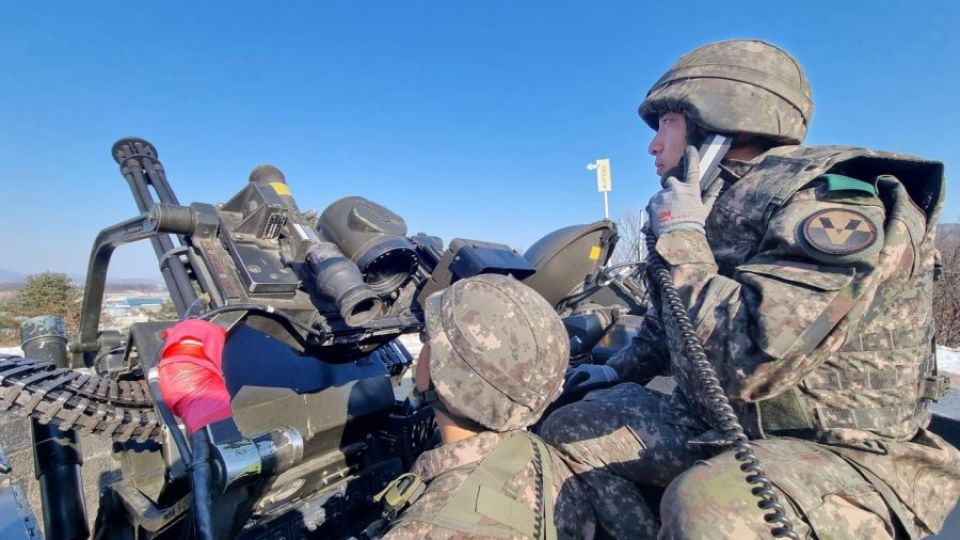January 10, 2023
SEOUL – South Korea’s Defense Ministry on Monday said that the military’s response to the cross-border infiltration by North Korean drones did not breach the armistice agreement, stressing that the countermeasure was essential to its right of self-defense enshrined in the UN Charter.
The ministry’s argument counters that of the main opposition Democratic Party of Korea, which said that the South Korean military violated the Korean Armistice Agreement by flying its reconnaissance drones north of the military demarcation line separating the two Koreas on Dec. 26.
The armistice agreement stipulates that air forces “shall respect the air space over the Demilitarized Zone and over the area of Korea under the military control of the opposing side.”
Underscoring the “legitimacy” of its tit-for-tat action, Jeon Ha-gyu, the Defense Ministry’s spokesperson, said the South Korean military “took corresponding measures against North Korea’s flagrant military provocation that clearly violates the armistice agreement, Inter-Korean Basic Agreement, and Sept. 19 military agreement.”
“We took the corresponding measure in light of our right of self-defense,” Jeon said, adding that the ministry went through an internal legal review.
“Article 51 of the UN Charter guarantees tit-for-tat action for the right of self-defense. As the armistice agreement is subordinate to the UN Charter, the armistice agreement cannot restrict (our right enshrined) in the UN Charter.”
Article 51 stipulates that the charter does not proscribe the “inherent right of individual or collective self-defense if an armed attack occurs against a Member of the United Nations.”
The UN Command — which is mainly responsible for reinforcing the 1953 Korean Armistice Agreement that brought the cessation of the Korean War — has been investigating whether the two Koreas breached the armistice agreement on Dec. 26.
But the Defense Ministry publicly elucidated its stance on the issue, given that the UNC has taken a case-by-case evaluation of whether the South Korean military’s countermeasures against previous North Korea’s cross-border offensives violated the Korean Armistice Agreement was legitimate.
In a previous case, the UNC acknowledged the legitimacy of the firing back by South Korea’s Marine Corps in response to the North Korean bombardment of Yeonpyeong Island in November 2010. At that time, the UNC said the South Korean military action was an exercise of the right of self-defense and did not breach the Korean Armistice Agreement and the UN Charter.
In contrast, the UNC concluded that the South Korean military violated the armistice agreement in May 2020 by returning fire after North Korea fired small arms directed at a guard post located south of the military demarcation line.
Meanwhile, the South Korean military has sought to come up with ways to take corresponding measures to prevent any future breaches by uncrewed North Korean aerial vehicles or UAVs.
The military has been reviewing the revival of a long-postponed defense project to develop low-cost miniature UAVs equipped with cameras and storage devices that are designed for long-range reconnaissance missions, a military official with knowledge of the matter confirmed to The Korea Herald on Monday.
The main mission is to infiltrate the enemy’s rear areas and take photos of key facilities in the rear areas, including the Sohae Satellite Launching Ground in Tongchang-ri, North Pyongan Province.
The Moon Jae-in government had tentatively decided to push for the envisioned defense project in the long term, which generally takes six to 17 years before the launch of the project. It declined the military’s requested to elevate the priority of the project, which was required to kick off the project within five years.
The then liberal-leaning government rejected the military’s plans to set up a unit committed to operating long-range reconnaissance drones in 2019, South Korea’s JoongAng Ilbo newspaper — which first reported on the project — said Monday.
The Moon government reasoned that the drones being considered would not be effective in emergencies because they are unable to transmit photos of enemy facilities in real time via a data link. The military has suggested that the Moon government postponed the project to facilitate inter-Korean reconciliation.
The military has been currently reviewing ways to redeem potential defects and enhance the military effectiveness of drones for long-distance reconnaissance, according to the unnamed official.


